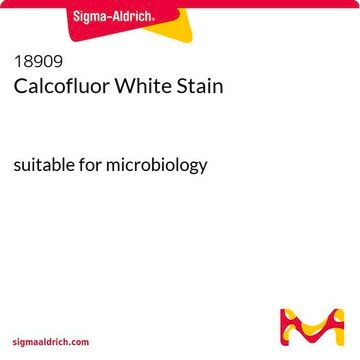72485
Nile Red
for microscopy
Synonym(s):
Nile Blue A Oxazone
Sign Into View Organizational & Contract Pricing
All Photos(1)
About This Item
Empirical Formula (Hill Notation):
C20H18N2O2
CAS Number:
Molecular Weight:
318.37
Beilstein:
279110
EC Number:
MDL number:
UNSPSC Code:
12171500
PubChem Substance ID:
NACRES:
NA.32
Recommended Products
grade
for microscopy
Quality Level
form
crystals
mp
203-205 °C (lit.)
λmax
553 nm
SMILES string
CCN(CC)c1ccc2N=C3C(Oc2c1)=CC(=O)c4ccccc34
InChI
1S/C20H18N2O2/c1-3-22(4-2)13-9-10-16-18(11-13)24-19-12-17(23)14-7-5-6-8-15(14)20(19)21-16/h5-12H,3-4H2,1-2H3
InChI key
VOFUROIFQGPCGE-UHFFFAOYSA-N
Looking for similar products? Visit Product Comparison Guide
General description
Nile Red is a phenoxazone dye. It is an important stain, which is used to detect intracellular lipid droplets and proteins. Nile Red detects lysosomes and lysosome-related organelles, like gut granules in C. elegans intestinal cells. It exhibits strong fluorescence enhancement and is used for staining SDS (sodium dodecyl sulphate) gels.
Application
Nile Red has been used:
- as a fluorescent dye for staining fat by confocal scanning laser microscopy (CSLM)
- to label nanoparticles (NPs)
- for lipid analysis
Storage Class Code
11 - Combustible Solids
WGK
WGK 3
Flash Point(F)
Not applicable
Flash Point(C)
Not applicable
Personal Protective Equipment
dust mask type N95 (US), Eyeshields, Gloves
Choose from one of the most recent versions:
Already Own This Product?
Find documentation for the products that you have recently purchased in the Document Library.
Customers Also Viewed
Influence of shear during enzymatic gelation of caseinate-water and caseinate-water-fat systems
Manski JM, et al.
Journal of Food Engineering, 79(2), 706-717 (2007)
Curcumin/Turmeric as an Environment-friendly Stain for Proteins on Acrylamide Gels
Polyphenols in Human Health and Disease, 779-784 (2014)
Importance of intrinsic properties of dense caseinate dispersions for structure formation
Manski JM, et al.
Biomacromolecules, 8(11), 3540-3547 (2007)
Influence of process parameters on formation of fibrous materials from dense calcium caseinate dispersions and fat
Manski JM, et al.
Food Hydrocolloids, 22(4), 587-600 (2008)
Protein Gel Staining Methods: An Introduction and Overview
Steinberg TH
Methods in Enzymology, 463, 541-563 (2009)
Our team of scientists has experience in all areas of research including Life Science, Material Science, Chemical Synthesis, Chromatography, Analytical and many others.
Contact Technical Service









